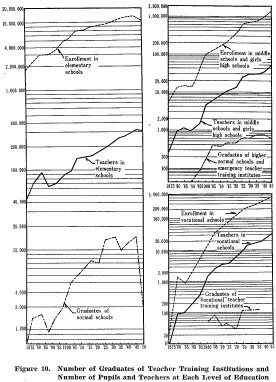| Home > Policy > White Paper, Notice, Announcement > White Paper > JAPAN'S GROWTH AND EDUCATION 1963 > CHAPTER |
||
It has been shown that elementary and secondary education in Japan entered the modern period from the early to the middle part of the Meiji Era. The expansion of these levels of education necessitated a program for the training and securing of teachers who were indispensable to this educational development.
It was immediately before the promulgation of the Government Order of Education, in the 5th year of Meiji (1872), that a normal school was established in Tokyo by the national government for the training of elementary school teachers. A little later, in 1875, secondary school teacher training was begun with the opening of the secondary school teacher training course at the Tokyo Normal School. Later, elementary school teacher training was taken over by public normal schools, and from 1883 it was so regulated that the number of future teachers to be trained at prefectural normal schools was to be decided by the national government in accordance with the number of school age children in the area under the jurisdiction of each prefecture. Such programed teacher training had always been in practice, though sometimes the consideration was also paid to the number of elementary school classes.
The training of teachers for middle schools and girls' high schools was conducted at higher normal schools since 1886, but enrollment in these schools lagged and the expansion of secondary education necessitated the establishment of emergency institutes for teacher training. Many of the secondary school teachers were recruited from among university graduates, or from persons succeeding in passing examination for a teacher's license. Vocational school teachers were recruited from among those who had a secondary school teacher's certificate or who were trained at a vocational teacher training institute in a specialized field.
The trend in the relations between the number of pupils and teachers in e1ementary and secondary schools and the number of normal school graduates is shown in Figure 10.

Comparison of the number of pupils and the number of teachers
in elementary school shows that the former increased continuously except during
the period 1885-90 and after World War ![]() ,
and the latter roughly corresponded to the same trend, though the average rate
of the increase in the latter is a little higher than in the former. In the beginning
of the Meiji Era when the number of normal schools were not sufficient yet, the
number of normal school graduates was inadequate to meet requirements. With a
few exceptions, the rate of increase in the number of normal school graduates
has exceeded the rate of increase in the numbers of elementary school pupils
and teachers, and the percentage of teachers qualified increased from 55 per
cent in 1895 to 89 per cent in 1935. After World War
,
and the latter roughly corresponded to the same trend, though the average rate
of the increase in the latter is a little higher than in the former. In the beginning
of the Meiji Era when the number of normal schools were not sufficient yet, the
number of normal school graduates was inadequate to meet requirements. With a
few exceptions, the rate of increase in the number of normal school graduates
has exceeded the rate of increase in the numbers of elementary school pupils
and teachers, and the percentage of teachers qualified increased from 55 per
cent in 1895 to 89 per cent in 1935. After World War ![]() elementary
school teacher training was shifted from normal schools to universities and the
percentage of qualified elementary school teachers reached 96 per cent in 1960.
elementary
school teacher training was shifted from normal schools to universities and the
percentage of qualified elementary school teachers reached 96 per cent in 1960.
At the secondary level, the enrollments in middle schools and girls' high schools increased at a relatively high average annual rate, and the increase in the number of teachers approximated the same curve. The sharpest rates of increase are noted in the decade beginning in 1890. The number of higher normal school graduates has never been adequate to meet the demand created by increased secondary school enrollments. And so, the recruitment of secondary school teachers had to rely also on university graduates and those who succeeded in the teachers license examination.
Much the same relative trend is shown for vocational schools, except that the training of vocational teachers was even more inadequate.
| Back to Top | MEXT HOME |